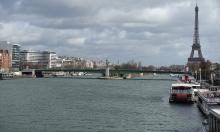USSR and USA designed and built nuclear monsters in Cold War era to blow up the globe
The Cold War was in full swing in the 1950s. The Soviet Union and the United States alike ended up inside the palings made of nuclear missiles. Politicians in both Moscow and Washington were confident that a deciding battle would be fought by soldiers walking knee-deep in radioactive aches. A slumbering mind on both sides of the Iron Curtain gave birth to combat monsters powered by nuclear reactors.

Part of those monstrously expensive novelties were doomed to gather dust in the archives, others were built as planned. Nobody knows what should be done about them these days. Now it is a lot easier to understand why virtually everything was in short supply back in the Soviet era. The arms race was the heaviest burden of all back then. Any budget could have been sucked dry by gargantuan military expenditure.
By the late 1950s, the super planners at the Soviet General Staff came up with a wonderful concept of using a battalion of marines for making a sea-launched assault on the U.S. coasts. Those trigger-happy strategists apparently dreamed about an overwhelming attack on Washington, red flags flying above the Pentagon and the White House… The Atlantic was the biggest setback. It was impossible to approach the United States without crossing the ocean first. The brass figured out that nuclear submarines would be an ideal means of transportation for the crossing of the Atlantic. But the subs should be large enough to carry a five hundred marines and tanks!
In 1960, a team of designers headed by chief designer N. Kiselyev at the Central Design Bureau No 16 made a first attempt to draw up a giant nuclear submarine capable of carrying marines and equipment. The transport sub was dubbed “project 664.” But the project never took off due to lack of shipyards available at the time in the Soviet Union. All shipyards were busy making nuclear missile-carrying submarines.
The brilliant plan of using marines for a blitz on Washington got a second wind in 1965. The Kisselyev team was assigned to a new project in order develop a huge undersea transport ship capable of making a discreet landing operation of 1,200 assault troops or a reinforced battalion of marines (470 men) and equipment including 3 floating tanks PT-76, 2 armored personnel carriers BTR-60, and 6 company mortars. The blueprints of a new sub were ready by August of 1965. The new sub had three parallel hulls. The side hulls were made for carrying wheeled and caterpillar-tracked military equipment, the central hull was made for carrying a crew and troops.
The tanks and APCs were supposed to roll ashore off the two ramps mounted on a flat “flounder-like” bow of the vessel. However, the project stalled in the end due to a constant lack of shipbuilding facility at the naval base in Severodvinsk.
The Soviet leaders were inspired by a real breakthrough achieved by the Soviet scientists in the development of nuclear power plants for the Navyin the early1950s.Therefore, the scientists were told to start developing aircraft powered by nuclear engines. Vladimir Rigmant, assistant to president of the JSC Tupolev speaks with a Trud correspondent about the program launched by the Soviet government for the purpose of building nuclear military aircraft.
“On August 12, 1955, the Soviet government actually ordered the Tupolev Design Bureau and the Myasishchev Design Bureau to begin developing an airplane with a nuclear engine. The military seemed under the spell of a concept of the dream plane, whose flight range would be virtually unlimited. The endurance of a crew would the only restrictive factor. By the late 1970s or the early 1980s, the Tupolev program was supposed to produce a series of military aircraft powered by nuclear engines.”
“Fortunately, those plans were never implemented, largely due to lack of funds. The state would have gone broke if one more nuclear project had gone under way. Besides, some sensible and farsighted officials in the government gave another thought to the project in terms of a flight safety. Could you imagine the consequences of an accident involving a nuclear-powered aircraft?”
Were any flight tests conducted at all?
“Initially, the designers needed to obtain data regarding the behavior of a nuclear reactor on board the aircraft in midair. The reactor was mounted on board the heavy strategic bomber Tu-95M. The bomber was used as a flying lab. It conducted 34 flights from May to August 1961. The next stage of the program envisaged using of a nuclear reactor as engine. The project was dubbed “project Tu-119”. The bureau was working on another project at the same time. The project was aimed at developing the long-range supersonic bomber Tu-120 to be powered by a nuclear engine.”
The Americans were reportedly making a huge effort trying to get their own nuclear plane off the ground…
“They spent about $10 billion on that program, but they failed to make a greater progress than we did. President John F. Kennedy pulled the plug on the program in 1961.”
And who pulled the pug on our program?
“Nikita Khrushchevcanceled it in 1960 shortly after a major meeting that discussed the prospects of the development of strategic weapons. At that meeting the aircraft designers reportedly estimated that ground personnel would need 24 hours to complete preparations of a nuclear aircraft for a flight. On the other hand, rocket designers represented by chief designer Sergei Korolev told the Soviet leader that a nuclear missile could be activated in several minutes. The rocket guys were reportedly very good at convincing Krushchev that the future armed conflict would comprise an exchange of nuclear missile strikes. Therefore, the building of strategic ballistic missiles and nuclear missile-carrying submarines became a priority.”
Trud
Translated by Guerman Grachev
Pravda.Ru
Subscribe to Pravda.Ru Telegram channel, Facebook, RSS!





